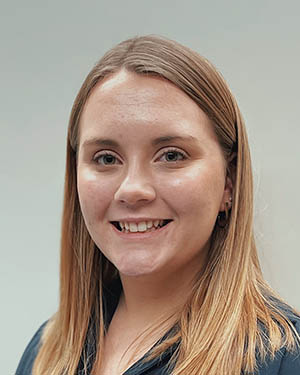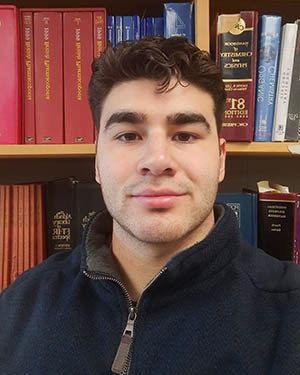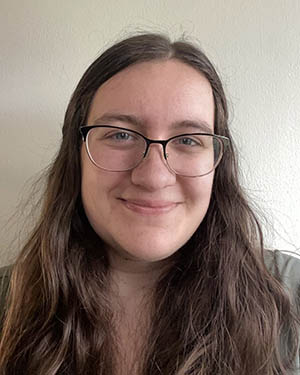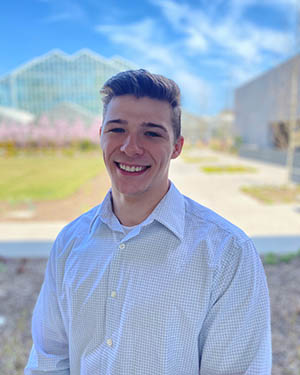Office of Research & Sponsored Programs
Ferris Library for Information, Technology and Education (FLITE)
Ferris State University
1010 Campus Drive, FLITE 410 D & F
Big Rapids, MI 49307
(231) 591-2547
[email protected]
Full Schedule of CELEBRATION OF STUDENT RESEARCH and CREATIVE ACTIVITIES
Student Fellow: Bryce Longenberger, Master of Social Work
Faculty Mentor: Dr. Janet Vizina-Roubal, Arts, Sciences and Education; Social Work
Posttraumatic Stress Disorder (PTSD) and dementia significantly impact the physical and psychological well-being of older adults. PTSD manifests in individuals who have encountered or witnessed traumatic events, while dementia emerges as a neurocognitive disorder affecting cognitive faculties and emotional processing. The first objective of this research project was to investigate the connection between PTSD and dementia in the elderly through a comprehensive literature review.
Current research underscores a heightened likelihood of a dementia diagnosis among older adults with PTSD. The causal link between trauma and dementia remains elusive, but evidence indicates a bidirectional relationship between these conditions. Researchers have also found substantial overlap in symptoms between PTSD and dementia, making it challenging to differentiate between them. This ambiguity poses difficulties for clinicians and healthcare providers seeking to diagnose and treat these conditions in older adults.
Consequently, the secondary aim of this study was to assess the efficacy of existing screening tools in distinguishing between trauma-related and cognitive symptoms in older adults. While established PTSD assessment tools like the CAPS-5 and PCL-5 have proven effective in diagnosing PTSD in older adults, their applicability to dementia patients remains uncertain due to unique symptom presentations. Currently, there is no comprehensive screening tool available to help clinicians differentiate between PTSD symptoms and dementia symptoms.
Therefore, the third and final objective of this research project was to develop a screening tool that could assist clinicians in distinguishing between trauma and cognitive-related symptoms in older adults. To achieve this, two existing trauma diagnostic tools – the Adverse Childhood Experiences (ACEs) Questionnaire and the PTSD Checklist for the DSM 5 (PCL-5) – were adapted to incorporate components enabling clinicians to discern whether specific trauma symptoms could be more appropriately attributed to a dementia diagnosis.
The revised diagnostic tool provides clinicians the possibility of more accurate diagnoses and targeted interventions, ultimately elevating the quality of care and support for older adults grappling with these complex challenges. The implications of these findings are profound for healthcare professionals, underscoring the need for a nuanced approach to comprehend and address the co-occurrence of PTSD and dementia in older adults.

Student Fellow: Amanda Branim, Business Administration
Faculty Mentor: Dr. Leslie Sukup, Business; Management
In an era where the world is grappling with the aftermath of COVID-19 pandemic, economic turbulence, and rising energy costs, it has become imperative to scrutinize various facets that influence the dynamics of the workplace. Central to this is the role of employees, who are unequivocally the backbone of any business. This research project embarked on the critical mission to explore whether resilience, a factor that has gained significant prominence in recent years, impacts job satisfaction, employee productivity, and varying staffing levels. This study aimed to shed light on this pressing issue which is pertinent to the ongoing shifts in the business environment.
The primary tool for data collection was a survey. Recruitment for participation was primarily conducted through social media and email campaigns, encouraging individuals to provide their insights by completing the survey. The survey included instruments to measure pivotal factors such as Resilience at Work, Job Satisfaction, and Productivity. Furthermore, we collected a few demographics such as the participants’ current and preferred modes of work.
As we ventured into the analysis phase in August, our data delineated a significant correlation between resilience and two critical aspects: job satisfaction and productivity. It became evident that resilience serves as a formidable predictor in determining an employee’s contentment and efficacy at the workplace. Contrarily, resilience does not predict or influence an employee’s preference for a particular mode of work or current work mode.
Currently, we are conducting analysis to uncover potential correlations that might exist beyond the preliminary findings. We anticipate that this exploration may unravel intricate patterns and deeper understandings, which could further assist organizations through the complex terrain of economic uncertainty, higher energy costs in the post-pandemic workplace. Through this research, we aspire to contribute valuable insights that can foster a resilient and thriving work environment for all employees.


Student Fellow: Bridgette Vedra, Optometry
Faculty Mentor: Dr. Alison Jenerou, Optometry
Purpose: Stroboscopic Visual Training (SVT) has gained increasing attention as a method for improving visual performance and sports-related skills among athletes. Stroboscopic goggles are used in SVT. The googles create a strobe effect with liquid crystal display lenses that adjust between settings to allow light through then to block the light. It is thought that when removing visual information, through the lenses blinking on and off, the brain may learn to process visual input more efficiently. This study investigates the effects of SVT on collegiate volleyball players and its impact on their passing skills.
Methods: Six collegiate volleyball players participated in this study. A pre-test was performed on each player evaluating their passing skill ability. The assessment consisted of a serve-receive drill in which 10 balls were served to each player and their passes were ranked on a 0-3 scale based on accuracy. Players were then randomized to the study group (players that trained wearing Senaptec Strobe Training Goggles) or the control group (players that trained as normal without stroboscopic goggles). Both groups completed the same training routine, three times a week, for four weeks equaling a total of 12 training sessions. After the four-week training period a post-test identical to the serve-receive pre-test was performed.
Results: A Mann-Whitney U test was used to compare the control group to the study group. The analysis revealed that there was not a statistically significant difference between the study group and the control group passing skill score. A Wilcoxon Signed Rank Test was performed for post-test results compared to pre-test results in the study group. The analysis revealed that there was not a statistically significant difference (p=0.06) between the study group pre-test and post-test ranks
Conclusion: Although the outcomes of stroboscopic visual training did not reach statistical significance, the proximity of the p-value to the threshold may suggest that with a larger sample size, the observed effects of SVT on volleyball players passing skills may attain statistical significance.


Student Fellow: Juan P Morales Zimbron, ICT (Manufacturing)
Faculty Mentor: Dr. Luis Rivera, Arts, Sciences and Education; Physical Sciences
Potential energy surfaces (PESs) are constructed to illustrate the H2O⋅⋅⋅ClF complex interaction energies as a function of five variables. The main objective of this summer research program was to find the minimal energies and optimal geometry of the H2O⋅⋅⋅ClF complex by using different levels of theory for ab initio calculations. In the first part of the research program, I focused on learning the NWChem software and getting familiar with the interface. For the next step in the project, we used the experimental data of the complex available in the literature to help us set up the ab initio calculations. We calculated 6000 energy points for each level of theory. Each point took between two and forty minutes to calculate depending on the accuracy of the theory being applied. These energy points were interpolated to find the minimal energy of the complex as well as the optimal geometry. The calculations were carried out at the MP2/aug-cc-pVDZ, MP2/aug-cc-pVTZ, and CCSD(T)/aug-cc-pVDZ levels of theory. For the CCSD(T)/aug-cc-pVDZ level of theory, the calculations were performed with and without corrections for the basis set superposition error (BSSE). Finally, the calculated potentials were combined to obtain a highly accurate potential. This combination gives us results similar to what we could obtain with the highly accurate and highly computationally expensive level of theory known as CCSD(T)/aug-cc-pVTZ. Which is sometimes referred to as the “gold standard”. All five potential functions were explored in the same way, providing us with the necessary data. The results obtained varied depending on the level of theory but our most accurate one produced a minimal energy of -3.94 kcal/mol, which is the most accurate value ever obtained for this complex. These results will be useful as an approximation for experimental research and as part of more accurate calculations for both the minimal energy and the optimal geometry. It is also worth noting that this project will continue to be developed to calculate the vibration-rotation energy levels of the complex and the prediction of experimental data.


Student Fellow: Makenna Karst, Architecture and Sustainability
Faculty Mentor: Kate O’Connor, M.Arch., Engineering & Technology; Architectural Technology & Facility Management
The community of Idlewild, located in Yates Township, Michigan, possesses a significant history as the largest historic African American resort community established during the Jim Crow Era. Established in 1912, it thrived for more than fifty years but declined with the passing of the Civil Rights Act in 1964. However, Idlewild has begun to revitalize, with a new influx of full-time residents that are seeking work-life balance in a rural context and, most importantly, residency in a safe community. However, the community infrastructure was originally designated for seasonal residents, resulting in a new set of needs for community sustainment.
Idlewild’s new needs are twofold: first, significant changes — beginning at the township level — to a system that will support full-time residents and second, progress that will respect the community’s historical African American origins. Significant concerns included rural tourism and cooperative economics, among other considerations, with special focus on research that engages with community visioning to develop planning that realigns community, township, and county goals for Idlewild.
The main objective of this particular project was to explore principles of the cooperative community structure and their application to Idlewild, and the aspiration for this process is to create a successful case study for other rural communities to begin planning and applying cooperative community modeling. The research included extensive literature review, community engagement, and active group communication to help form a basis for the township master planning processes. There was a clear need for a new zoning map, and one result of this project was the creation of an unofficial map that was used as a tool in the master planning process.
Community leaders also identified a need for a way to communicate these seemingly complex ideas to members of the community. In an effort to educate individuals on these principles, the main focus of the research turned to the development of a set of infographics explaining solidarity economics. The results on the effectiveness of these graphics is not yet apparent, but the hope is that the people both in and outside of the Idlewild community develop a better understanding of the possibilities of the cooperative community structure and its application to their own communities.


Student Fellow: Kathryn DeSanti, Biology
Faculty Mentor: Dr. Eric Nybo, Pharmacy; Pharmaceutical Sciences
Macrolide antibiotics are used in treatment for pneumonia and sexually transmitted infections. The rise of macrolide-resistant bacteria has motivated the development of new structural analogs that can overcome drug resistance. Streptomyces venezuelae ATCC 15439 produces the macrolides pikromycin, methymycin, narbonolide, and 10-deoxymethymycin through a pik-encoded assembly line polyketide synthase (PKS). This system generates both 12-membered and 14-membered macrolides, and the resulting macrolactones are offloaded and modified via glycosylation. The macrolides are enriched through fermentation of the producing organism.
In this work, we used Streptomyces venezuelae ∆desI (DHS8708) as an expression host for the generation of new macrolide analogs. We overexpressed several plasmid cassettes driving the biosynthesis of different TDP-deoxysugars in this strain. We successfully exchanged the native D-desosamine sugar for a D-ravidosamine sugar, resulting in the production of four new macrolides.


Student Fellow: Chase Rasmussen, Pre Physician Assistant Studies – Biology Program
Faculty Mentor: Dr. Jim Van Treese, Arts, Sciences and Education; Social and Behavioral Sciences
This study attempts to identify different factors that play a role in each undergraduate student’s decision to pursue graduate education. The choice of bachelors versus masters versus doctoral degree can be very difficult, and the path chosen affects the student for the rest of their life. Review of literature finds almost no information on the factors students consider. Therefore, undergraduate academic advisors are completely on their own in helping students make this choice. To allow advisors to better assist these students, research must be done to show the most important factors that are a part of the student’s decision. The purpose of this project is to begin to identify the most important factors in a student’s decision of a master’s versus a doctoral graduate degree. In this study, we surveyed students in the Pre-Medicine and Pre-Physician Assistant programs at Ferris State University. These students were asked a variety of questions about what factors helped them make their decision between a doctoral career field in Pre-Medicine versus a master’s degree field in Pre-PA. The survey was a brief list of yes or no questions pertaining to a set of factors that we thought may be some of the largest factors involved in a student’s decision. Students completed the survey online. We received a limited number of responses, which makes drawing any certain conclusion very difficult. However, we did learn enough information to provide guidance to future studies of this topic. This research will serve as a pilot study for the psychology research team this academic year.


Student Fellow: Danique Walker, Nursing
Faculty Mentor: Dr. Susan Owens, Health Professions; Nursing
BACKGROUND
Healthcare professionals have been called upon to reduce the carbon emissions we produce
because they directly affect the health of our populations. The Healthcare Without
Harm Report’s (2019) priority action recommendation is to reduce healthcare's climate
imprint. The Paris agreement of 2015 states to decrease global warming at the end
of the 21st century carbon emissions should decrease by 50% in 2030 and be "0" by 2050. The world
is falling short of this goal and nurses have been called to action. Strengthening
climate education is considered a tipping intervention strategy that will increase
awareness and help decrease carbon emissions. The Planetary Health Report Card (PHRC)
for healthcare programs will be used as a gap analysis to understand strengths and
areas for growth and be a metric to track progress on implementing curriculum and
gaining resources. The PHRC consists of five criteria to rate healthcare programs.
METHODS
A literature review was completed to understand the history behind the Planetary Health
concept, what research was conducted, and found evidence for education and practice.
The PHRC was used to understand the baseline of the FSU SON score. The five criteria
for ratings are curriculum, interdisciplinary research of health and environment,
community outreach, support for student led planetary health initiatives, and sustainability.
PLAN
A cumulative grade was given combining all criteria scores. The criteria questions
were answered by reviewing the SON curriculum, website, policies, and surveying faculty.
Once the grades were assessed, an evidence-based plan was developed to guide improvement
of all criteria.
RESULTS
The percentages observed reflect the need for improvement in all areas. Curriculum
is the best criteria at 36%, introductory efforts are noted for individual courses.
Strategies for widespread implementation of the interconnectedness between weather
events and health throughout program curriculums is recommended. Continued faculty
engagement with planetary health research is also recommended with a dedicated committee
to oversee its effectiveness. Some introductory efforts are made in laboratory sessions
for reusable materials; however, more work needs to be done in this and all five criteria.
Further, students must have more opportunities to engage in local environmentally
sustainable initiatives.


Student Fellow: Kody Drewer, Optometry
Faculty Mentor: Dr. Vandana Rajaram, Optometry
Background: Mindfulness practice is thought to enhance attention and self-regulation1,2. We investigated the impact of a single, brief mindfulness session on reflexive and
voluntary visual attention (VA) reaction times (RT) measured with the Posner Cueing
Task (PCT)3.
Methods: Participants (N=30) were young adults, ages 20-30. VA orienting was measured using
a modified web based PCT paradigm. One week after baseline measurements, testing was
repeated immediately after subjects listened to a 10-minute mindfulness session on
the Calm-app.
Results: Two-way Analysis of Variance was performed to analyze the main effects. Results were
statistically significant for both the Voluntary (F(2, 174) = 10.97, p < 0.007) and
Reflexive (F(1, 174) = 13.81, p < 0.0002) VA-RT.
Conclusions: Our findings suggest that even a single, brief mindfulness session can significantly
enhance both reflexive and voluntary VA orienting. Since attention plays a key role
in visual tasks such as reading4 and driving, its enhancement through brief mindfulness training could have positive
implications for such tasks. As a caveat, we cannot entirely discount the effects
of practice on VA improvement. Additionally, we do not know if these findings apply
to other patient demographics. These limitations can be the focus of future investigations.


Student Fellow: Sydney Starmer, Pharmacy Program
Faculty Mentor: Dr. Minji Sohn, Pharmacy; Pharmaceutical Sciences
Fluoroquinolone antibiotics (FA) are a class of wide-spectrum antibiotics with many severe side effects including tendon rupture, mental status changes, hypoglycemia, arrhythmia, and aorta tearing. For these reasons, medical professionals are recommended to use other non-fluoroquinolone antibiotics (NFA) with narrower ranges and fewer side effects and use FA only if a NFA-based treatment fails or alternative drugs are unavailable. This choice not only benefits the patient receiving antibiotics but also increases antimicrobial stewardship, which is the effort to measure and improve how antimicrobials are prescribed and used. Collaboration to Harmonize Antimicrobial Registry Measures (CHARM) through Ferris State University’s College of Pharmacy worked with a health system in Michigan to examine whether patients receive NFA before they receive FA. Between January 2019 and April 2023, a total of 4,844 patients received one or more FA prescriptions. Of those, 3,781 (78.1%) did not have any record of receiving an NFA before they used an FA. 1,064 (22.0%) were prescribed one NFA before a FA within 60 days. 267 (5.5%) were prescribed two NFAs before a FA within 60 days. 72 (1.5%) were prescribed three or more NFAs before a FA within 60 days. The top five most common NFA prescribed were cephalexin, doxycycline, nitrofurantoin, sulfamethoxazole-trimethoprim, and azithromycin. Based on our data, a majority of patients receiving FA prescriptions appeared to use the drug without trying a safer alternative. Future research can further analyze the encounter type in which these antibiotics were utilized (hospital, primary care, urgent care, etc.) to investigate if this relates to any FA versus NFA prescription patterns.

